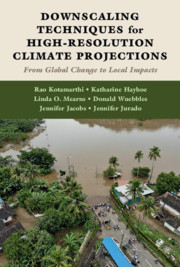Book contents
- Downscaling Techniques for High-Resolution Climate Projections
- Downscaling Techniques for High-Resolution Climate Projections
- Copyright page
- Contents
- Preface
- 1 Impacts, Adaptation, Vulnerability, and Decision-Making
- 2 Global Climate Models
- 3 Assessing Climate-Change Impacts at the Regional Scale
- 4 Dynamical Downscaling
- 5 Empirical-Statistical Downscaling
- 6 Added Value of Downscaling
- 7 Uncertainty in Future Projections, and Approaches for Representing Uncertainty
- 8 Guidance and Recommendations for Use of (Downscaled) Climate Information
- 9 The Future of Regional Downscaling
- References
- Index
7 - Uncertainty in Future Projections, and Approaches for Representing Uncertainty
Published online by Cambridge University Press: 05 February 2021
- Downscaling Techniques for High-Resolution Climate Projections
- Downscaling Techniques for High-Resolution Climate Projections
- Copyright page
- Contents
- Preface
- 1 Impacts, Adaptation, Vulnerability, and Decision-Making
- 2 Global Climate Models
- 3 Assessing Climate-Change Impacts at the Regional Scale
- 4 Dynamical Downscaling
- 5 Empirical-Statistical Downscaling
- 6 Added Value of Downscaling
- 7 Uncertainty in Future Projections, and Approaches for Representing Uncertainty
- 8 Guidance and Recommendations for Use of (Downscaled) Climate Information
- 9 The Future of Regional Downscaling
- References
- Index
Summary
Future projections are uncertain, for multiple reasons. Limits to scientific understanding of natural variability, structural and parametric uncertainty in scientific modeling, climate sensitivity, bias correction and downscaling all play a role. The uncertainty due to human choices that will determine emissions of heat-trapping gases becomes increasingly important over time, to the point where it dominates the uncertainty in many aspects of global and regional change by the end of century. Quantifying how a given system will respond to a changing climate adds yet another layer of uncertainty that can be prohibitively large in systems that are complex and/or not well understood. Understanding the source of these uncertainties and how they can be addressed when applying downscaled climate projections to assess future impacts is essential to quantifying the range of future change and resulting impacts on human and natural systems
Keywords
- Type
- Chapter
- Information
- Downscaling Techniques for High-Resolution Climate ProjectionsFrom Global Change to Local Impacts, pp. 121 - 138Publisher: Cambridge University PressPrint publication year: 2021



